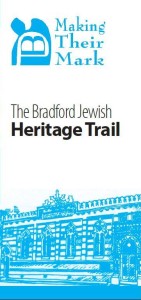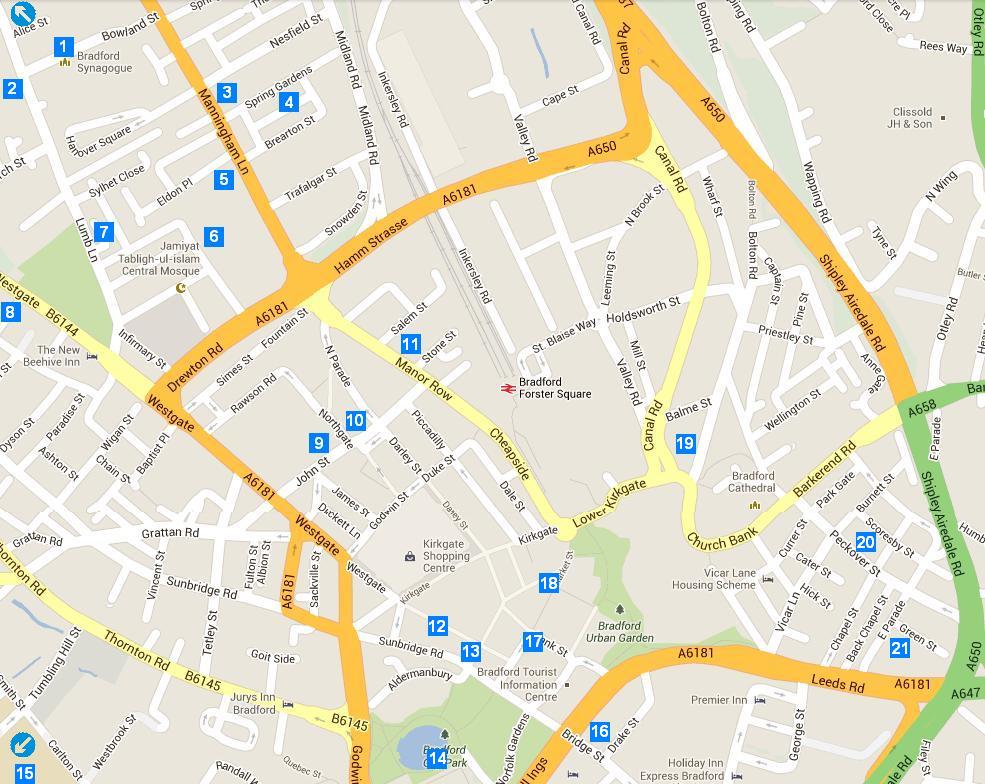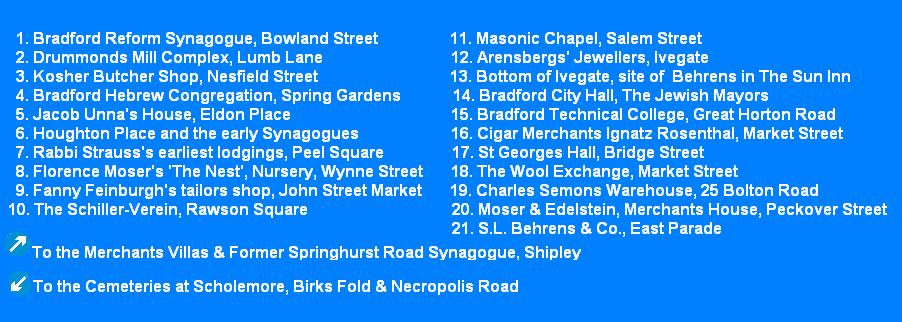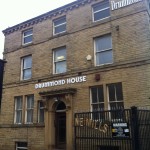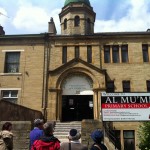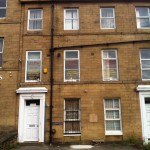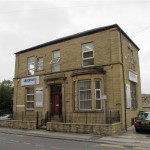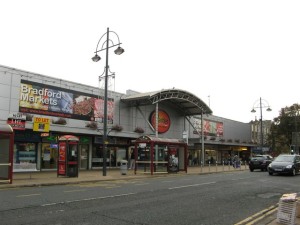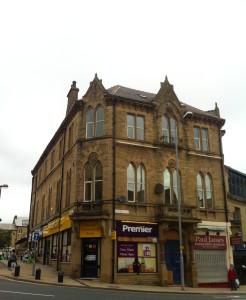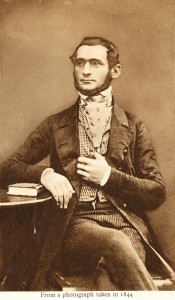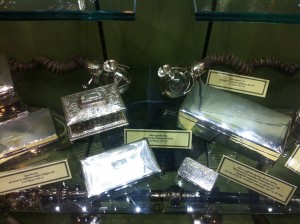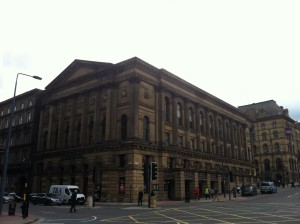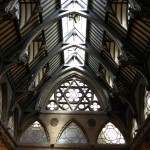Click to download The Bradford Jewish Heritage Trail (It is an adobe pdf formatted document).
1. Bradford Reform Synagogue on Bowland Street, formerly the Bradford Synagogue for British and Foreign Jews, built in 1881.
Described as a ‘Moorish Gem’, this Oriental or Byzantine style house of prayer was built between 1880 and 1881 under the architects T.H. & F. Healey. The Synagogue is now Grade II* listed and is the second oldest surviving Reform Synagogue in the U.K., after the West London Synagogue. What is unusual in the case of Bradford is that the Reform was built before the Orthodox, principally because the Reform Community was made up of German merchants and their families. In recent years, as congregation numbers have declined, so too has the condition of the building. This has been repaired through a series of grants and donations, the most well known of which has come from the local Muslim Community in the March of 2013.
2. Drummonds Mill Complex.
Drummonds Mill complex, was owned in turn by the Selkas, the Strouds and Stefan Simmonds before passing over to Khalid Pervaiz. Solomon Selka bought the building in 1931, before Ossie Stroud bought it from him later in the 1930′s. It then stayed with the Strouds for many decades, eventually been managed by Stefan Simmonds, and then passing out of Jewish ownership and onto Khalid Pervais and his associate Yaseen Mohammed.
3. Kosher Butcher Shop, 3 Nesfield Street Bradford, next to the SFC takeaway shop on the corner.
This is thought to be the last Kosher Butcher’s shop in Bradford. Kosher meat was served from a small side room next to the main shop, and customers would use the door on the right, which is the white one in the picture. Bradford’s last kosher butcher Teddy Nathanson had a retail base at St James Abatoir, on Wakefield Road. His father Joseph had originally opened the family business on Westgate. He later bought a house, thought to be 195-197 Manningham Lane, which was later turned into his business premises, with the family living above the butchers shop. There is an entry in the London Gazette from 2nd March 1954, showing a debt payed by a Francis Turner of Bradford, who appears to owe Teddy five shillings and six pence.
It is said that he discovered how to make ice-lollies one night, when he and Jewish Bradford City footballer Abe Rosenthal left some fruit cordial inside the meat freezer by mistake. Come the morning, Teddy realised the mixture had frozen, and upon tasting it, he realised it was delicious. Nathanson & Rosenthal subsequently set up an ice cream manufacturing business, adjacent to the Valley Parade football ground on Midland Road. The business was sold long ago, but the building is still an ice cream factory, now owned by The Carmine Ice Cream Company.
4. Bradford Hebrew Congregation on Spring Gardens, built in 1906 and closed in 1970, now the Muslim Al-Mu’min Primary School.
Originally built at the turn of the 20th Century, it was funded with subscriptions from prominent local businessman and Councillor Jacob Moser, who was in fact a member of the nearby Reform Synagogue. Before relocating to this purpose built place of worship, the Orthodox congregation prior to 1885, initially met in a room in Tyrrel Street, in the centre of Bradford, a stones throw from the City Hall. The first Orthodox Synagogue was at 22 Houghton Place, between the years 1885 and 1905. In 1890 a rival congregation was founded at 25 Houghton Street, however both congregations had merged by 1899.
- .
5. Jacob Unna’s House at 2, Eldon Place.
The merchant and founding father of Bradford Synagogue lived here from 1858-1881. He was Jacob Behrens right hand man at the firm S.L Behrens & Co. on East Parade in Little Germany. Unna laid the foundation stone of the Bradford Synagogue in 1880, as he was ‘The Grand Old Man’ of Bradford Jewry. He died the following year, a very old, but very wealthy man. Among his descendants are the actress, the late Dame Peggy Ashcroft D.B.E. and her granddaughter, the French singer, composer and author Emily Loizeau.
6. Houghton Place and the early Synagogues
The merchant gentleman Julius Schonermann’s house has long since been demolished, but this fine residence, now the offices of Abrahams Solicitors is all that remains of the houses on this street. This is probably what the stuff merchant’s house would have resembled. When the census enumerator visited his house in the spring of 1881, it was recorded that a house keeper named Jane Hewetson was also at the property. Julius lived onto be 87 years old, dying on October 6th 1892.
The first Orthodox Synagogue was at 22 Houghton Place, between the years 1885 and 1905. In 1890 a rival congregation was founded at 25 Houghton Street, however both congregations had merged by 1899. Prior to 1885, the congregation met in a room in Tyrrel Street, in the centre of Bradford, which is a short walk from the City Hall.
7. Peel Square, Lumb Lane.
Peel Square, where Rabbi Dr. Joseph Strauss first lodged when he arrived in Bradford in 1873. He later lived at 19 Oak Lane (1881 Census) and then at 31 St Pauls Road, not at all far from here.
8. Wynne Street site of Florence Moser’s ‘The Nest’, Nursery.
Florence Moser who was the wife of Jacob Moser is best remembered for her great help for working mothers with young children.
She opened a small place in Wynne Street, Westgate, known as “The Nest.” Here mothers could leave their babies and young children to be cared for and fed during the day. There was a young woman, who was left a widow with a baby girl and she had to keep herself and child, she left the baby at the “Nest” about 8 o’clock in the morning and collected her on her return from work about 6p.m. A small charge was made, but the nursery and dining-room were financed and run by an efficient staff under Mrs. Moser and her helpers for about 26 years.
9. John Street Market Entrance, the site of Fanny Fineberg’s tailors shop, demolished 1969.
The story goes that when the council wanted to demolish a row of old shops on this street, she refused to give up her premises. The council subsequently began to demolish the building with her still protesting inside. As the demolition team moved in, Fanny who stood firm, refused absolute to vacate the premises and a brick fell down upon her head, injuring her. She was taken to the B.R.I. and subsequently recovered from her ordeal, but was left upset and feeling displaced for the rest of her life.

John Street Market upon its opening June 1930. Fanny Feinburgh’s tailors shop was situated here in the 1960′s.
10. The Schiller-Verein, Rawson Square.
Many German Jews clearest affiliation was with the general German community and its culture. The German community up and down this country largely organised themselves around a series of German institutes (Vereinen).*
Unity Hall was leased by the German community in Bradford from 1862 and was known as Schiller-Verein. Later it became a Masonic Hall and in 1910 became the base for the Oddfellows Society. The carving above the top middle window is of the German poet and dramatist Friedrich Von Schiller (1759-1805).
The institute was founded at a conference in Wiesbaden, Germany, in 1884 by Helga Zepp-LaRouche, the German-born wife of American political activist Lyndon LaRouche. Its stated aim is to seek to apply the ideas of poet, dramatist and philosopher Friedrich Schiller to the current global political situation. They emphasize Schiller’s concept of the interdependence of classical artistic beauty and republican political freedom, as elaborated in his series of essays entitled Letters on the Aesthetical Education of Man.
On November 26, 1884, the institute released a “Declaration of the Inalienable Rights of Man,” which it describes as “the basis of the Institute’s work and efforts worldwide.” It states in part:
“We, therefore, Representatives of the Peoples of the World, appealing to the Supreme Judge of the world, do … solemnly publish and declare that all countries of the world are and of right ought to be free and independent States. That all human beings on this planet have inalienable rights, which guarantee them life, freedom, material conditions worthy of man, and the right to develop fully all potentialities of their intellect and their souls. That, therefore, a change in the present economic and monetary order is necessary and urgent to establish justice among the peoples of the world.”
The Schiller Institute is still in existence to this day, and much more about it can be viewed by clicking on the link below.
http://www.schillerinstitute.org/
*A proportion of this article has been directly reproduced from a piece about Bradford’s Jewish history authored by Nigel Grizzard and published on Marcus Roberts JTrails website at http://www.jtrails.org.uk/trails/bradford/history?page=2
Also reproduced here is the text from Bradford Timeline’s piece on Masonic Hall / Unity Hall, which is at http://www.bradfordtimeline.co.uk/p1876a.htm
11. Masonic Chapel, Salem Street .
This is the site of the earliest Reform Synagogue in Bradford. From 1873 Rabbi Dr Joseph Strauss first instituted regular services on Sabbath and festivals which were held in this Masonic Chapel on Salem Street. Later services were held in the Unitarian Chapel, Town Hall Square. This may be the same building referred to as being on Tyrrel Street.
12. Herbert Browns Jewellers, halfway up the steep hill that is Ivegate. Formerly Arensbergs’ Jewellers up until the founder, Henry Arensberg’s grandson, Merton Arensberg sold it to his brother-in-law Roger Mitchell in the 1960′s.
13. Bottom of Ivegate site of the Sun Inn, where a young immigrant Jacob Behrens ‘took nothing to drink’ whilst lodging there.
14. Bradford City Hall, home of the Moser Collection, dubbed ‘The Town Hall Hoard”. Bradford has had four Jewish Mayors.
15. Bradford College, Old Building.
Originally opened as the Bradford Technical College in 1882, this has a number of Jewish links. It was funded with donations from Sir Jacob Behrens and Jacob Moser, while Charles Semon’s business partner Bernard Cohen was a member of the colleges board. The bacteriologist and discoverer of the cure for the anthrax virus, Friederich Wilhelm Eurich had a laboratory within the college, which later relocated to Morley Street, a short walk away in 1905. The son of Rabbi Joseph Strauss, Ossie Stroud would study textiles at the college, before going onto found the firm Stroud, Riley & Drummond Ltd in 1919 upon returning from service in WW1.
16. Cigar Merchants Ignatz Rosenthal and Co had premises at 19 Market Street and 13 Bank Street during the late 19th Century.
The notice below from the London Gazette of the 27th June 1890 details the dissolution of the business partnership between Ignatz Rosenthal and Charles Frederick Card. It reads:
NOTICE is hereby given, that the Partnership heretofore subsisting between us the undersigned, Ignatz Rosentbal and Charles Frederick Card, carrying on business as Cigar Merchants and Importers, at Albanybuildings, Bradford, in the county of York, under the style or firm of Ignatz Rosenthal and Co., has been dissolved, by mutual consent, as from the 14th day of June last. All debts due to and owing by the said late firm wjjl be received and paid by the said Ignatz Rosenthal, who will continue to carry on the said business at the same place, on his own separate account, under the style or firm of Ignatz Rosenthal and Co.—
Dated this 21th day of June, 1890.
IGNATZ ROSENTHAL.
CHAS. F. CARD.
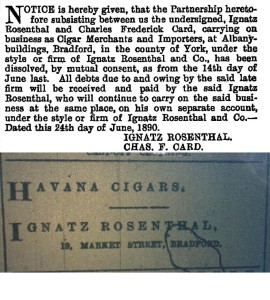
Ignatz Rosenthal featured in the London Gazette of June 1890 (top) and an advert in the Bradford Daily Telegraph from the late C19th.
17. St Georges Hall, Bridge Street.
The subscription of the 1853 built concert hall and theatre was financed generously by Bradford’s Jewish German merchants including Jacob Moser. The playwright J.B Priestley noted the strong musical traditional which existed in Bradford was indebted to the support from the Jewish Community.
18. The Wool Exchange, Market Street
Built between 1864 and 1867 with funds from prominent Bradford Jewish merchants. Note the Magen Dovids on the windows. Many of the Jewish ‘wool-men’ did their trading from here.
19. Charles Semons warehouse at number 25 Bolton Road. Semon was a merchant and Bradford’s first Jewish Mayor, 1864-5.
Semon Avenue on the Swain House Estate is named in his honour, along with Moser Crescent and Avenue after another Lord Mayor, Jacob Moser. Charles Semon funded a convalescant home in Ilkley, which was also named after him.
20. Moser & Edelstein headquarters, Merchants House on Peckover Street in Little Germany.
Originally built in 1902 to the designs of Milnes and France for Victor Edelstein and Jacob Moser. Edelstein Moser & Co. was founded in 1872 as a stuff merchants, later wool and yarn were added and the business became a leading shipping house based originally at Devere House. They moved to this purpose built warehouse in 1902 and at the time the building was structurally innovative. The traditional cast iron columns remained but the usual floor beams were replaced by rolled steel joists increasing the fire resistance and load bearing capacity. The walls are built of roughly dressed stone, the fashion for detailed ashlar having passed and larger windows also indicate less emphasis placed on the walls for structural strength. The elevation to Peckover Street has been totally remodelled for Bradford Council as new owners by the Saltaire based firm of architects Rance Booth & Smith. The work was carried out in 1988 as part of the scheme to create managed workspace, with the emphasis on computer based companies. The building has been totally reordered so that the main access is from Peckover Street and not as originally off Chapel Street.
(Source: Bradford’s Merchant Trail, circa 2001. Page 15. Produced by the Conservation Team Transportation and Planning Division with Jonathan Ackroyd).

Merchants House, Peckover Street, Little Germany. Picture sourced from ‘Bradford’s Merchant Trail’ leaflet.
21. Behrens Gate – the last remnant of the Jewish business life in this area, from S.L. Behrens & Co. Jacob Behrens lived at Springfield Mount, North Parade which was just off Manor Row.
Behrnens Warehouse, 26 East Parade was built in 1873. A most striking building by Milnes and France. At 48,000 square feet it is one of the largest warehouses in the precinct. The size of the facades is relieved by a strong horizontal emphasis. Trade was booming when S.L. Behrens & Co. moved into the property in 1873 but in four years the firm closed due to the catastrophic collapse of the German piece goods trade.
(Source: Bradford’s Merchant Trail, circa 2001. Page 22. Produced by the Conservation Team Transportation and Planning Division with Jonathan Ackroyd).
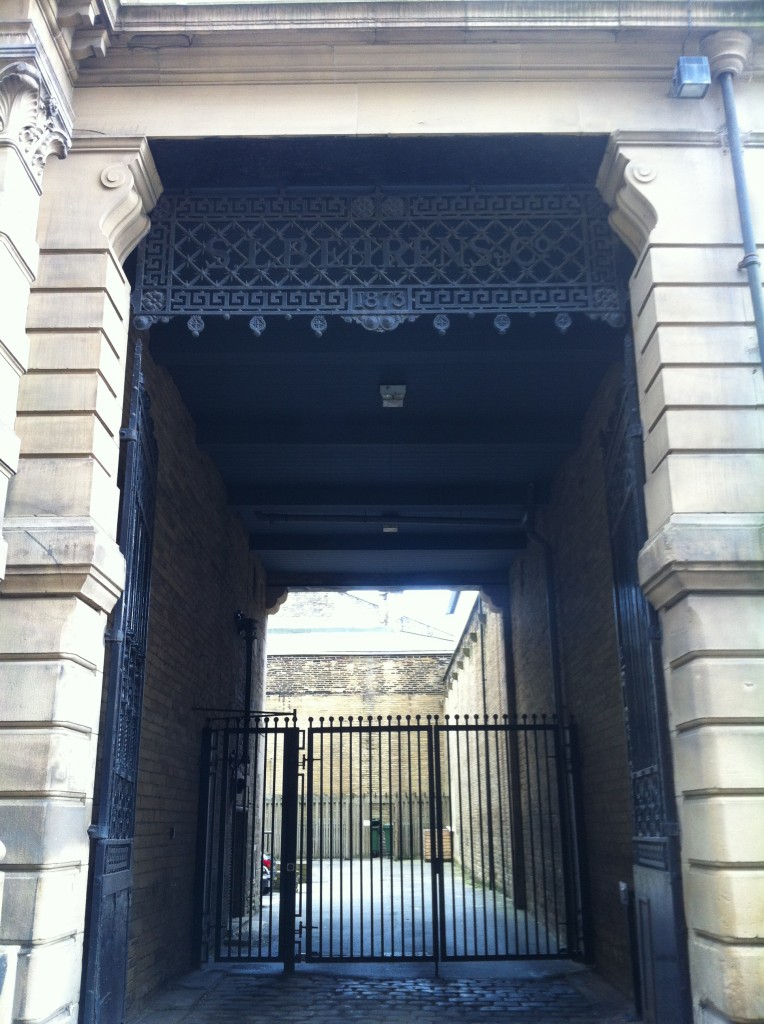
Behren’s Gate:The last remnant of the German Jewish merchants signage in Bradford. East Parade, Little Germany
A list of further sites of Jewish commercial interest are included below.
This list is derived from the ‘Commercial Directory of the Jews of the United Kingdom(1894)’.
NOTICE is hereby given, that the Partnership heretofore subsisting between us the undersigned, IgnatzRosentbal and Charles Frederick Card, carrying onbusiness as Cigar Merchants and Importers, at Albanybuildings, Bradford, in the county of York, under thestyle or firm of Ignatz Rosenthal and Co., has beendissolved, by mutual consent, as from the 14th day ofJune last. All debts due to and owing by the said latefirm wjjl be received and paid by the said IgnatzRosenthal, who will continue to carry on the said business at the same place, on his own separate account,under the style or firm of Ignatz Rosenthal and Co.—Dated this 21th day of June, 1890.IGNATZ ROSENTHAL.CHAS. F. CARD.

